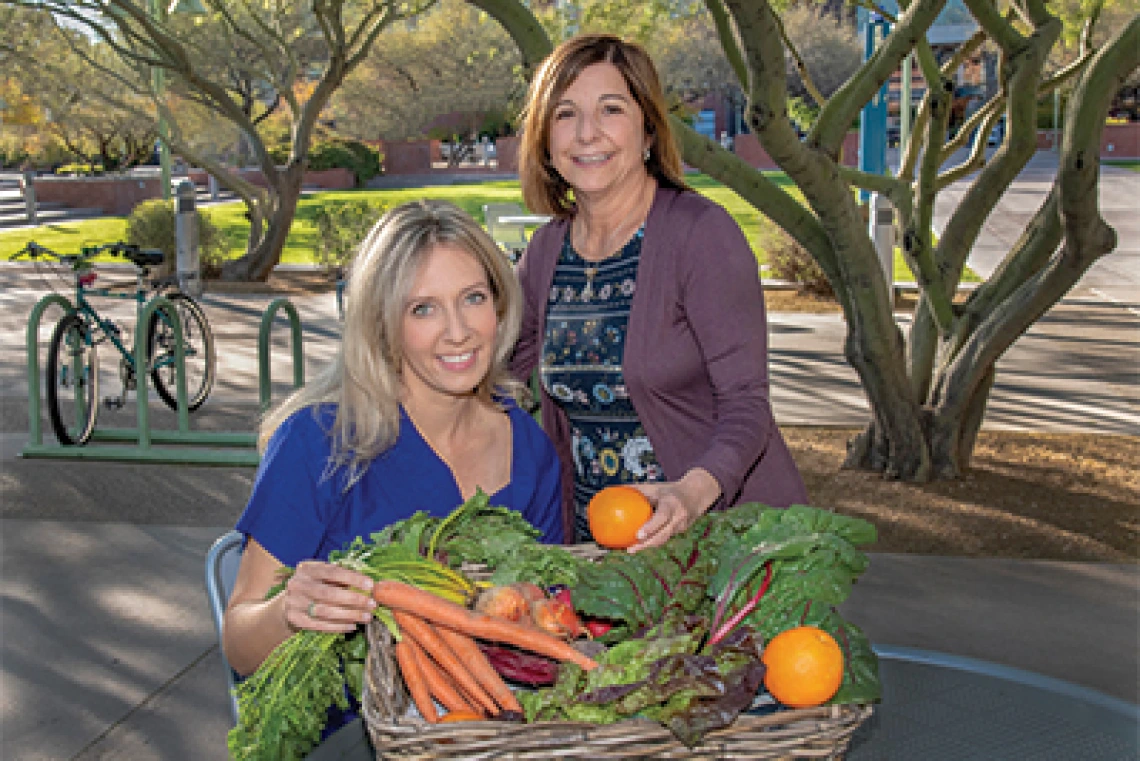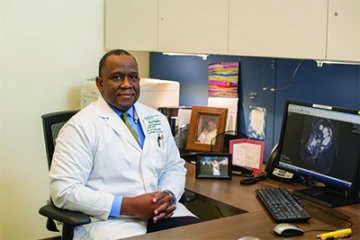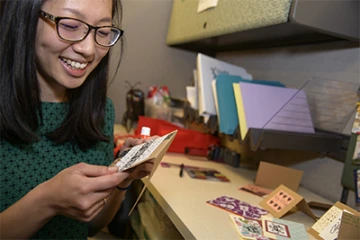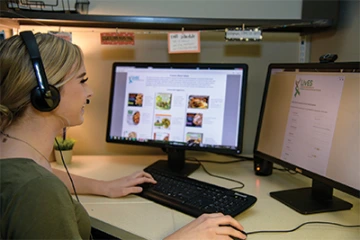An Intervention with Heart
UArizona Health Sciences LIvES study uses the power of personal connections to help ovarian cancer survivors forge healthier habits

Tracy Crane, PhD (left), and Cynthia Thomson, PhD, RD
Tucked away on the third floor of the Pima County Health Department is a suite of offices housing University of Arizona undergraduate students and their faculty mentors. Armed with telephone headsets and an array of crafting supplies, they are at the center of one of the largest and most ambitious efforts to extend lifespans of ovarian cancer survivors.
Ovarian cancer is relatively rare, striking 1 out of 78 women. But it also is one of the deadliest cancers, with only 44% of patients surviving five years past their diagnosis. After their disease goes into remission, many patients worry the cancer will return.
“When treatment is over, there is a ‘respite’ when patients start to feel better and go back to living their lives,” says Janiel Cragun, MD, assistant professor of obstetrics and gynecology at the UArizona College of Medicine – Tucson. “But in the back of their minds, there is the psychological concern of disease recurrence. Their No. 1 fear is that it’s going to come back.”
Many physicians advise patients to make positive changes in diet and exercise, as these choices lay a foundation for good health overall.

John Farley, MD, helped recruit ovarian cancer survivors to the LIvES trial. (Tabbs Mosier, UArizona College of Medicine – Phoenix)
“I would like patients to keep active,” says John Farley, MD, professor of obstetrics and gynecology at the UArizona College of Medicine – Phoenix. “The more active you are, the more likely you are to keep the cancer from coming back.”
Shaping one’s own survivorship through lifestyle changes is an empowering idea.
“These women have survived cancer. Being able to take control of something is important,” says Tracy Crane, PhD, assistant professor at the UArizona College of Nursing. “Patients ask, ‘I’m done with treatment — now what?’”
A team at the University of Arizona Health Sciences is answering that question in the form of a rigorous study called LIvES — Lifestyle Intervention for Ovarian Cancer Enhanced Survival, the first study to investigate if ovarian cancer survivors can enjoy a longer period of wellbeing through healthful changes in lifestyle and behavior.
Based on previous evidence that physical activity and a plant-based diet could lower cancer risk, the team hypothesized that these lifestyle changes also could prolong survivors’ respite from the disease, stretching out the time it takes for ovarian cancer to return — if it comes back at all. Participants aim for a daily intake of four servings of vegetables, two servings of fruit, 30 grams of fiber and no more than 20% of total calories obtained from fat.
“We had growing evidence suggesting that diet and physical activity matter, not only in terms of risk but perhaps in terms of long-term prognosis,” says Cynthia Thomson, PhD, RD, who oversees LIvES nationwide and is co-leader of the Cancer Prevention and Control Program. Her team set out to test that idea.
Laying the groundwork
LIvES initially was conceived more than a decade ago by Dr. Thomson and David Alberts, MD, now UArizona Cancer Center director emeritus. Dr. Crane was a graduate student when, beginning in 2008, she helped prepare LIvES for launch. Now a co-investigator, her feelings toward the project are downright maternal.
“If I buy people one more day that’s a healthy, happy day, that would be great.”
Cynthia Thomson, PhD, RD
“I had all three of my babies in the time it took for us to get this study up and going,” Dr. Crane recalls. “Dr. Alberts likes to joke that LIvES was my fourth baby. It’s been a huge part of my life.”
By June 2012, LIvES was recruiting participants from all over the nation. In August 2018, they reached their goal, recruiting a total of 1,205 participants from 300 centers in nearly every state. The team is slated to finish collecting data in August 2020, when the last participant completes the program.
“The intervention is centralized in Arizona,” Dr. Thomson says. “We are responsible for training our health coaches, for evaluating them on a regular basis and for doing the quality control. We make sure this trial is conducted with the highest level of rigor and integrity.”
Telephone coaching is at the heart of LIvES, and participants receive regular phone contact over a period of two years. From the program’s headquarters in the Pima County Health Department, LIvES coaches have talked to all 1,205 study participants. Public health students coach the “control group,” which is made up of survivors who receive 22 coaching sessions covering general health topics, such as the importance of hydration and sun safety. Dietetics students coach the “intervention group,” which receives 33 coaching sessions centering on diet and physical activity goals. At the end of the study, the control group will be compared to the intervention group to see if the program made a difference, not just in terms of survival but also in quality of life.

Angela Yung, a data manager for LIvES, puts a personal touch on handmade cards sent to ovarian cancer survivors. (Photo: Kris Hanning)
The training process for coaches is intense. Intervention coaches undergo several months of training, learning all about ovarian cancer and the particulars of diet and exercise. On top of everything else, coaches engage in multiple practice calls to prepare for a variety of situations. These roleplaying sessions culminate in a final phone call with Dr. Thomson.
“It was close to 30 minutes, and you’re on your feet for most of the call,” says intervention coach Emily Diana of that “graduation” call. “It’s nerve-wracking — you want to pass and start doing what you’ve been training to do for so long.”
By the time they receive their degrees, the student-coaches demonstrate high-level competency in health coaching.
“It doesn’t seem like it would be possible to ask busy undergraduate students to do this, but they do and they thrive,” says lead coach Sarah Wright. “They grow so much, and have gone on to amazing things because they’ve had this early experience.”
Building bonds
Intervention coaches learn a patient-centered counseling technique called “motivational interviewing.”
“The patient is always in the driver’s seat with motivational interviewing. We’re drawing upon the individual and what they want to work on, versus the coach telling them what they’re going to work on,” Dr. Crane explains. “It’s like when you were a kid reading ‘Choose Your Own Adventure.’ We’re trying to get them to this one overall goal of eating healthier and exercising more, but how they get there can look different.”
Coaches start out with frequent phone calls, which are important in establishing rapport and helping participants become self-sufficient early in the program. As they continue their journey into survivorship, the tone and frequency of these interactions adapt to meet the survivors’ changing needs. Coaches often become a vital component of their support network.
“After you’ve gotten through treatment, you’re not coming back to the clinic for follow up as often,” says Dr. Crane. “The coaches serve as a branch of their health care team.”
The emotional support coaches offer participants might be just as important as the diet and exercise information they provide. Their ability to build these bonds with participants is indispensable.
“They’re amazing,” says Dr. Thomson. “They form a rapport with these women that goes beyond meeting the goals of the study. It’s a much broader and deeper commitment to their wellbeing.”
The emotional support coaches offer participants might be just as important as the diet and exercise information they provide. Coaches send hand-made cards to participants to acknowledge sad news, like the recurrence of a patient’s cancer, and happy news, like the birth of a grandchild or accomplishing a health goal.
The connection built through telephone conversations over the course of two years is buttressed by other forms of personal contact. Drawing from a full stock of craft supplies, coaches send hand-made cards to participants to acknowledge sad news, like the recurrence of a patient’s cancer, and happy news, like the birth of a grandchild or accomplishing a health goal.
“It’s a way that we can physically connect with our participants,” says study coordinator Meghan Skiba, MS. “A card lets them know we hear them and we care. The whole team is supporting them through both the negative and positive experiences that come with survivorship.”
“They see a different side of you, even if it’s something small like your handwriting,” adds bilingual intervention coach Sofia Grijalva. “It’s another little connection you make. They love it.”
When coaches sign up for their two-year stints with LIvES, they must prepare to take on the emotional ups and downs that come with survivorship.
“It’s hard when someone you’ve talked to for 18 months has a recurrence. Those calls are heartbreaking, and there are often tears,” Wright says. “But the vast majority of calls are positive, exciting or optimistic. That keeps you going through the calls that are more difficult.”
“Every day is an emotional rollercoaster,” Grijalva adds. “You never know what you’re going to get, but we’re there to support them. That is the most rewarding thing about this job.”
Healthy, happy days

McKenna Scheldt is a research assistant for LIvES, the largest research effort to extend lifespans of ovarian cancer survivors. (Photo: Kris Hanning)
LIvES is popular with participants — and that high esteem is reflected by glowing exit interviews and a low dropout rate.
“A lot of times, when there are new drugs and you worry about side effects, patients can be a little hesitant about participating in trials,” Dr. Farley says. “LIvES encourages a lot of natural things — dietary changes, exercise — which are generally appealing to patients.”
At the UArizona Cancer Center, both Drs. Cragun and Farley recruited ovarian cancer survivors to join the study, and hope the results will equip them to give well-rounded advice to ovarian cancer patients beginning their survivorship journey.
“We’re so focused on disease-free progression that we lose sight of quality of life,” Dr. Cragun says. “We need to move away from the mentality of ‘treat at all costs’ and pay more attention to survivorship. In the future, I hope we can extend survival without sacrificing quality of life.”
When the last patient completes the study next year, the resulting data will form the backbone of the largest lifestyle intervention trial conducted with ovarian cancer survivors. Drs. Crane and Thomson both anticipate that when this trial is done the results will make national headlines.
“This is a huge trial,” Dr. Crane says. “There’s been nothing else like it, and I’m not sure there will ever be anything like it again.”
“My whole world is about preventing disease,” Dr. Thomson adds. “Even if I buy people one more day that’s a healthy, happy day, that would be great.”
Our Experts
Contact
Health Sciences
Office of Communications
520-626-7301
public@arizona.edu

